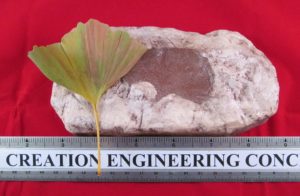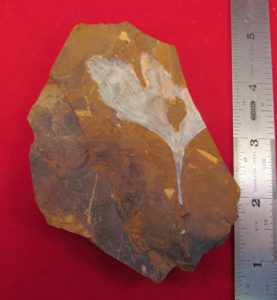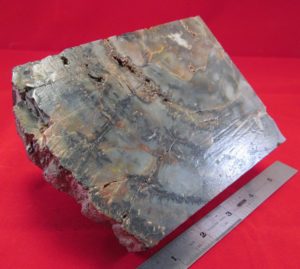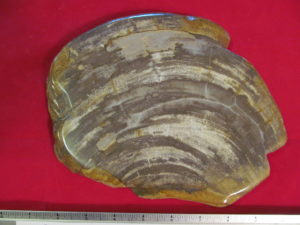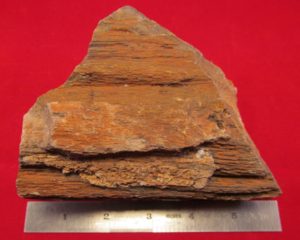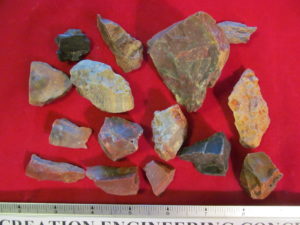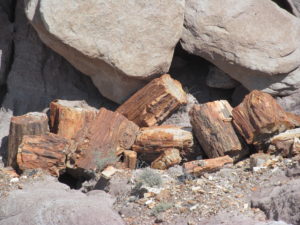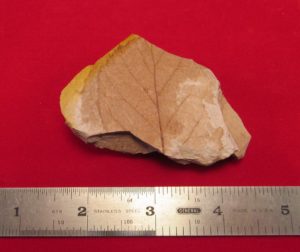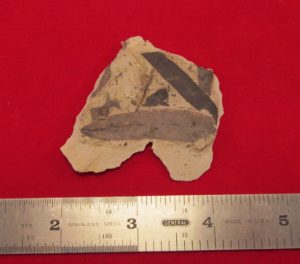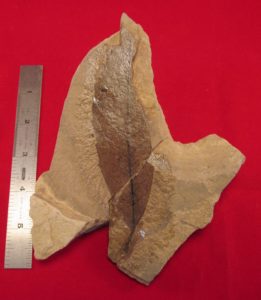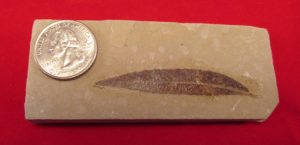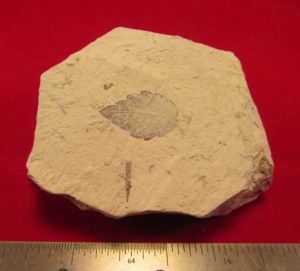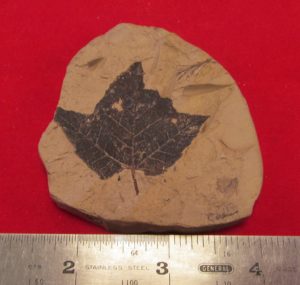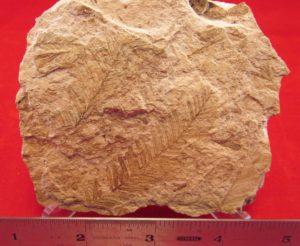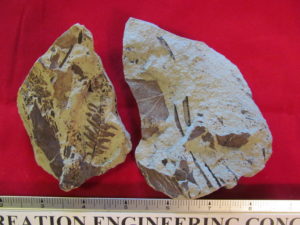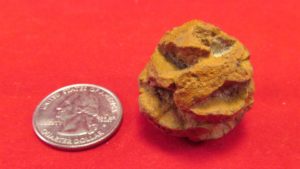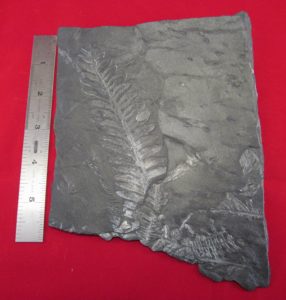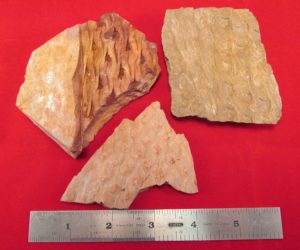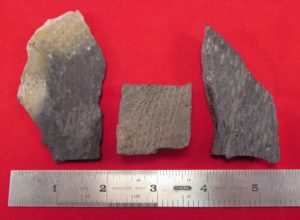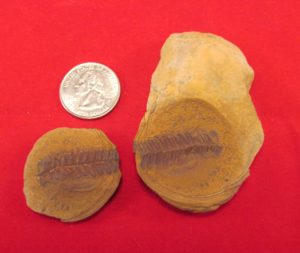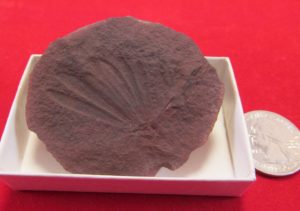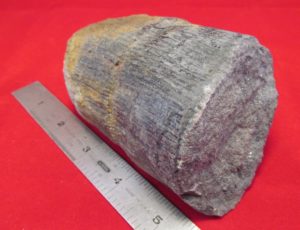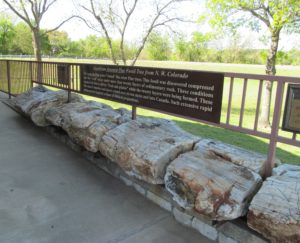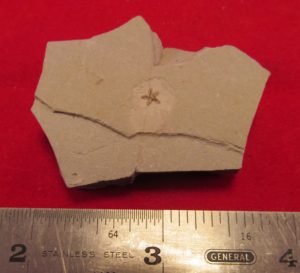All fossil images and descriptions ©2017 all rights reserved. Contact us for permission policy.
Ginkgo Leaves and Fossil Wood
Description: The replica fossil Ginkgo biloba leaf is 2 1/2″ wide X 1 3/4″ high in a 6 1/2″ long X 3 1/2″ high matrix. A modern leaf shown is nearly identical to the fossil replica.
Location: Replica leaf unknown. Extant leaf from Oregon.
Interpretation: The secular view is that the fossil leaf is 270 million years old. Since the same leaf exists today, Ginkgo biloba is a living fossil. The author has a live Ginkgo biloba tree in his backyard from which the modern leaf in the photo was obtained. The biblical creationist explanation is that the fossil leaf was rapidly buried in the catastrophic worldwide Flood at the time of Noah about 4,500 years ago.
#OR22
Description: The Ginkgo adiantoides fossil leaf is 2 7/8″ high X 1 3/4″ wide and the matrix is 4 1/2″ high X 3″ wide X 1/4″ thick. A portion of the leaf is broken off along with the matrix on the right hand side.
Location: Sentinel Butte Member, Fort Union formation, Morton County, North Dakota.
Interpretation: Leaves on the author’s Ginkgo biloba tree can be split or not split, which is an indication that this characteristic is not a defining one for determining species. Ginkgo adiantoides and G. digitata are two species names assigned to fossil leaves from the rock record along with G. biloba, a still living species. This variation within a kind indicates that God probably created one family of Ginkgo in the beginning. Most biblical creation scientists believe the created kind is closest to the family level, a larger variation-encompassing category than genus and species.
#OF19
Description: The piece of Ginkgo petrified wood is 2 3/4″ wide X 2″ high X 13/16″ thick. The grain of the wood runs parallel to the bottom and top edges of the specimen.
Location: Ginkgo Petrified Forest State Park, Vantage, Washington.
Interpretation: Evolutionists teach that petrified wood is formed slowly over millions of years during which time minerals gradually replace the wood cells as the wood rots away. But, in cases where the wood grain has been replaced with minerals to leave the same structure as before, it makes more sense that this was a relatively quick process assisted by heat, pressure and lots of water filled with minerals. The discussion of the rapid wood petrification process is found below in the section on rainbow wood from Arizona.
#OF9
Petrified Wood
Description: Some of the exterior bark can be seen along the left edge and several growth rings are visible circling the center toward the upper right. The cut section has been polished and painted with a preservative. The block is 5 1/2″ wide X 4 1/4″ high X 2″ thick and weighs just over three pounds.
Location: Unknown.
Interpretation: Petrified wood is found all over the earth. That is verification that the Genesis Flood was not a local event.
#OF8
Description: This petrified polished slab is 8 1/4″ X 8 3/4″ X 13/16″ thick. Rings and bark are visible in the specimen.
Location: Thought to be from either Indonesia or the Philippines.
#OF32
Description: The specimen of petrified Araucarioxylon wood is 3 3/4″ wide X 5 1/2″ long X 2 1/2″ thick and weighs almost two pounds. The surface looks like wood but has been completely turned to stone.
Location: The Chinle formation in northeastern Arizona, near Petrified Forest National Park.
Interpretation: The specimen is an example of the “Rainbow Wood” and is from a tree with the genus name Araucarioxylon. The biblical creationist notices that the petrified trees of the large area encompassing the Petrified Forest National Park are laying down flat and with many largely in a preferred orientation. Also, the tree branches are stripped and many of the logs are broken into short chunks. There is no standing forest at all. All the the remnants have been made into petrified wood by molecular replacement of the original wood with the mineral silica.
The rainbow wood “forest” is best explained as having been transported to where it currently rests by a large amount of water or mud. It is, as seen today, a result of the global Flood cataclysm at the time of Noah. The fossilization process can also best be attributed over such a large area to special conditions only in place during this one-time year-long Flood.
Scientific experimentation has shown that rapid petrification of wood takes place in five stages:
- Entry of silica in solution or as a colloid into the wood.
- Penetration of silica into the cell walls of the wood’s structure.
- Progressive dissolving of the cell walls which are at the same time replaced by silica so that the wood’s dimensional stability is maintained.
- Silica depositions within the voids within the cellular wall framework structure.
- Final hardening (lithification) by drying out.
#OF14
Description: A sample of pieces of petrified wood from the Arizona petrified forest. These pieces are all from outside the boundaries of the Petrified Forest National Park.
Location: Arizona.
Interpretation: These pieces of petrified wood are all highly silicified and are very hard and brittle. Hardness is usually between 7 and 8 on the 1-10 mohs scale. The red colors are due to the presence of hematite, a form of oxidized iron. Orange is due to the presence of geothite which is a hydrated iron oxide. White is produced by pure silica most commonly occurring as quartz or silicon dioxide. Green is produced by pure reduced iron. The black color is from either organic carbon or pyrite (iron sulfide).
So, the element iron (Fe) can be seen to play an important part for causing the rainbow of pretty colors in the Arizona petrified wood.
#OF33
Description: A photo of a fossilized wood pile that is accumulating as it erodes out of the hills of the Petrified Forest National Park.
Location: Chinle formation of NE Arizona.
Interpretation: The evolutionary view is that petrified wood is the result of very slow processes over millions of years. That flies in the face of our experience in the world today. The cataclysmic actions of the Flood make for a much better explanation.
Petrified wood weighs 160 to 200 pounds per cubic foot. This is about the same as a number of other types of rock like granite, limestone and marble. Man-made concrete weighs in the range of 144 to 150 pounds per cubic foot. Regular wood from the living trees ranges from 23 to 48 pounds per cubic foot. Compare these weights to 490 pounds per cubic foot for steel and 62.4 pounds per cubic foot for liquid water at 50 degrees F.
Description: This petrified tree limb section is 2 1/4″ maximum width X 1″ maximum thickness X 6 7/8″ long. The exterior of the specimen retains the characteristics of the original wooden limb. minus the bark.
Location: Recovered From La Paz County, Arizona.
Interpretation: La Paz County is located on the western edge of Arizona. The rainbow wood previously discussed is mostly from the areas around Petrified Forest National Park which is on the eastern side of Arizona. Clearly the petrification process was different for this piece than it was for those found in eastern Arizona. Nevertheless, petrified wood in a myriad of conditions is very common throughout globe.
#OF34
Other Fossil Leaves
Description: This incomplete fossil leaf is about 1 3/4″ wide. The matrix is 2 7/8″ wide X 1 3/4″ high X 5/8″ thick.
Location: John Day formation in Wheeler County, Oregon.
Interpretation: In the John Day Fossil Beds of Central Oregon large masses of plant fossils (mostly leaves) are found. Among the common leaves found are birch, elm, maple, oak, hickory, alder and beech. The leaf in the photo above looks to be from either a birch or poplar tree.
The leaves in these plant fossil masses are very similar, or identical, to the leaves we find on the same types of trees today. The author’s biblical creationist explanation for these leaf masses is that they were formed rapidly by massive movements of water-laden sediments during the worldwide Flood about 4,500 years ago.
#OF3
Description: The largest Salix (willow) leaf in the matrix is 1 7/8″ long X 7/16″ wide. The matrix is 1 3/4″ X 2 1/2″ X 1/4″ thick.
Location: Eastern Oregon.
Interpretation: This leaf fossil is possibly from the John Day Fossil Beds of Oregon. To form it had to be rapidly and completely buried in some way generally not seen today. The likely event was the one-year-long global Flood described in the Bible.
#OF4
Description: This leaf in mudstone is likely a Salix (willow) leaf and is 5 5/8″ long X 1 3/8″ wide. The fossil was broken and glued back together at a joint about two inches from the stem end. The leaf has been coated with shellac for preservation. There are nine “teeth” along the left edge and the right edge is 75 percent missing.
Location: Owyhee Mountains in Idaho.
Interpretation: Willows are a flowering plant that the Bible says God created on Day Three of the creation (see Genesis 1:11-12). Fossil leaves of many kinds of plants are commonly found in the clays, volcanic ash and other fine sediments that resulted from the global Flood. These fossil willow leaves are the same as today’s leaves, yet there is little evidence that leaves are still being fossilized in lakes or rivers today.
#OF20
Description: The fossil Salix leaf is 2 1/2″ long X 3/8″ wide and the matrix is 1 1/2″ wide X 3 3/4″ long. Teeth are visible along the edges of the leaf.
Location: From Utah, exact location unknown.
Interpretation: There is no discernible difference between this leaf from the rock record and extant Salix leaves growing on willow trees today. This is another example of a living fossil.
#OF21
Description: The Zelkova (elm) fossil leaf is 13/16″ long X 9/16″ wide and the matrix is 3″ long X 2 1/4″ wide X 11/16″ thick.
Location: Erdobenye, Zemplin Mountains, Hungary.
Interpretation: This delicate fossil elm leaf has the same basic shape and design as leaves on elm trees today, yet is thought to be 25 million years old by evolutionists. In reality, we see variation within plant kinds, but no macroevolutionary march from one plant kind to another entirely different kind. That reality is the same in the extant plants of today as well as in the fossil plants from the rock record.
If Zelkova fossil leaves are formed into fossils in a continuing uniformitarian manner over millions of years, then we should see them in consolidated sediments that we know are 100, 500 or 1,000 years old. But, fossilization does not seem to happen according to the gradual conditions of evolutionary theories laid out in secular textbooks. It make sense that these leaves were fossilized in a non-uniformitarian event. The cataclysmic Genesis Flood is the best explanatory candidate!
#OF22
Description: The fossil Acer (maple) leaf is 1 3/4″ wide X 1 11/16″ high. The matrix is 2 1/2″ wide X 2 5/8″ high X 7/16″ thick. The stem extends from the bottom of the leaf 5/16″ and is 1/32″ wide. A portion of the center-right of the leaf is missing from the fossil.
Location: Brown Coal Mine in Bilina, Bohemia, Europe.
Interpretation: This fossil leaf species Acer tricuspidatum is basically identical to the extant maple leaf species Acer rubrum that today ranges from the maritime provinces of Canada to Florida and west to Texas and Minnesota. This is another of the hundreds of identified living fossils.
#OF28
Description: The fossilized Metasequoia leaves are 11/16″ wide maximum with one 2 1/2″ long and the other 1 1/2″ long. The matrix is 3″ X 3 1/2″ X 5/16″ thick. Each needle is arranged opposite another corresponding needle on the other side of the stem.
Location: John Day formation of the John Day Fossil Beds of Oregon.
Interpretation: The tree represented by the twigs in the photo above was only known from fossils until it was found growing in China in the 1940s. Also known as dawn redwood, it is one of the more famous examples of a living fossil with some evolutionists exclaiming that its discovery was “like finding a live dinosaur.”
Metasequoia trees are now cultivated all around the world. The giant Sequoia trees found in California have their needles place on the stems in an alternate fashion rather than opposite like the Metasequoia. The two types of trees also have slightly different seed cones.
#OF5
Description: A grouping of partial fossilized leaf imprints in matrix. Left hand specimen is 2 1/2″ X 1 1/4″ thick X 3″ long. Right one is 3 3/8″ X 7/8″ thick X 4 3/4″ long. The stem with needles in the left piece is 3/4″ wide X 1 5/8″ long.
Location: Eagle Creek formation of Clackamas County, Oregon.
Interpretation: The conifer stem may be from a Metasequoia tree. It is difficult to be sure due to its poor condition. Clackamas County is on the western side of the Cascade Mountains in Oregon. The John Day Fossil Beds are on the eastern side.
#OF35.
Sequoia Seed Cone
Description: The permineralized fossil Sequoia seed cone approximates a 1 1/8″ sphere. The scales are staggered instead of vertically arranged. The typical scale is diamond shaped and is 5/8″ wide X 1/4″ high.
Location: Hell Creek formation of South Dakota.
Interpretation: Both Sequoia and Metasequoia trees are living fossils that are similar but different in a number of important ways. The seen cone design and the stem/needle design are two of the differences. When the seed cones for these trees are found as fossils, the seeds have usually already fallen out of the cones. This fact provides some insight for the creation scientist for what time during the year-long Flood that the cones were buried.
God’s creation is amazing in millions of ways. Consider that living things have what is needed for reproduction already packed into their DNA. And God said, let the earth bring forth grass, the herb yielding seed, and the fruit tree yielding fruit after its kind, whose seed is in itself, upon the earth and it was so (Genesis 1:11). So in this verse God said He was providing the fruit and seeds for reproduction and for food. And, even today, plants provide our food in abundance either directly or indirectly. Bible verses always profide unique and profound knowledge that is found nowhere in evolutionary theories.
#OF27
Alethopteris Fern Frond
Description: The largest Alethopteris fossil fern frond in the black shale slab is 5″ long X 1 1/2″ wide. Leaflets are attached to the stalk along widened bases and are oriented obliquely to the stalk. The largest leaflets are 1/4″ wide X 3/4″ long. The matrix is 5 1/2″ X 7 1/4″ X 1/4″ thick.
Location: Pennsylvania.
Interpretation: Evolutionists believe flowering plants evolved from plants like these Alethopteris ferns. But, ferns grow in warm, swampy areas and it could be expected that they would often be buried by the Flood lower in the sediments compared to flowering plants.
#OF7
Lepidodendron Bark Patterns
Description: Fossil Lepidodendron specimen OF10-1 (upper left) is 3 1/2″ long X 2 3/4″ wide X 1″ thick. Its triangular shaped scars are in rows 1/2″ apart on 1 1/8″ centers and are 1/8″ deep. Fossil specimen OF10-2 (upper right) is 3″ long X 2 3/4″ wide X 5/8″ thick with an irregular scar pattern. Fossil specimen OF10-3 (lower) is 3 1/4″ long X 2 1/2″ wide X 1/4″ thick. Its diamond shaped scars are in rows 3/8″ apart on 7/16″ centers.
Location: Upper Silesia formation near Czerwionko, Poland.
Interpretation: The Lepidodendron fossils are the most common lycopod plant found in the rock record. They are noted for their scale-like bark patterns, as seen in the photo. These patterns vary not only species to species, but also within the height of individual trees that have been found to have grown to be over one hundred feet tall and with trunks up to six feet in diameter.
The differences in Lepidodendron bark patterns are similar in amount of variety to those seen in today’s conifer trees, although lycopods are more like reeds rather than trees. Today’s lycopods are represented by small club mosses that never approach the size of fossil lycopods.
The biblical creationist asks: Did God create all of the variety seen in the Lepidodendron bark designs at the beginning, or are the variations due to adaptations, allowable by the DNA, that occurred during the 1,600 years between the creation and the Flood?
#OF10
Lycopods and Petroleum
Description: Fossil specimen OF10-5 (left) is 3 1/2″ long X 2″ wide X 3/16″ thick. Its scars are in rows 3/32″ apart and on 5/16″ centers. Specimen OF10-4 (center) is 1 3/8″ square X 3/4″ thick, Its diamond shaped scar pattern tends to vary as it spirals around a circumference. Specimen OF10-6 (right) is 2 3/4″ long X 1 1/4″ wide X 7/16″ thick with an irregular scar pattern. These specimens of bark fossils from lycopod plants have a petrochemical smell and color.
Location: Upper Silesia formation of Poland.
Interpretation: The secular view is that fossil lycopod plants are indicators of a particular time period millions of years ago. Many of the fossil lycopods are commonly found associated with coal-bearing strata. Coal miners often mistakenly believe lycopod bark fossils are snake fossils because of the scale-like patterns found on them.
Creationists propose that the petroleum products extracted from the earth’s crust today are the consequence of massive plant matter mats that were modified to their present form by temperature and pressure after rapid burial during the global Flood. Plant fossils as well as other types of fossils are often found in coal seams, and that fact meshes with the creationist hypothesis better than the slow accumulation of vegetable matter in peat bogs, the best evolutionary story for coal, gas, and oil.
#OF10
Neuropteris Fern
Description: The Neuropteris leaflet is 15/16″ wide X 2 3/4″ long and the nodule is 2″ wide X 3 1/16″ long X 7/8″ thick. A 1/8″ wide curved tear in one side of the leaflet is visible in both halves of the fossil.
Location: Mazon Creek fossil bed in Grundy County, Illinois.
Interpretation: The Mazon Creek fossil beds are of interest because both hard and soft tissues of many different kinds of animals and plants are preserved in concretions there. The formation consists of about one hundred feet of shale and most of the fossils are found in its lower fifteen feet or so. The nodules are called “ironstone” because dissolved iron from the water was involved in the fossilization process, and the iron is noticeable in the concretions. The Neuopteris is the foliage of an extinct type of fern that reproduced by seeds instead of spores.
The formation of these Mazon Creek nodules required rapid burial and unusual conditions seldom, if ever, experienced today. If the process of saving the fossil was a gradual one the item inside the nodule would have deteriorated to nothing. The seed fern that this Neuropteris leaflet represents grew in abundance prior to the worldwide Flood, but was not able to re-establish itself after the Flood.
#OF12
Pecopteris Fern
Description: The Pecopteris tree fern frond is 1 3/16″ long X 3/8″ wide. The larger nodule piece is 1 3/4″ wide X 2 3/4″ long X 11/16″ thick. The shape of this fossil-bearing nodule is highly unusual.
Location: Mazon Creek fossil bed in Grundy County, Illinois.
Interpretation: A tree fern plant left this fossil frond segment as testimony to the Genesis Flood. Pecopteris is considered extinct today as it was unable to re-establish after the Flood.
#OF16
Annularia Leaf
Description: The fossil Annularia leaf whorl imprint is 1 7/8″ wide X 1 1/4″ high and the nodule half-section is 2″ diameter X 7/16″ thick. The largest leaf in the whorl is 1/8″ wide X 1 1/8″ long.
Location: Mazon Creek fossil bed in Grundy County, Illinois.
Interpretation: The Annularia leaf has a separate genus name from the Calamites tree on which it grew. This indicates how difficult it can be to properly analyze the fossils that are the result of the worldwide cataclysm. Fossils of the now extinct Calamites indicate that it grew to heights of as much as one hundred feet. The much smaller horsetail rush (Equisetum) is a similar plant to Calamites that still exists today.
#OF15
Calamites Tree Stem
Description: The Calamites fossil cast (not a replica) is 2 3/4″ wide X 4 1/8″ long. It is 1 7/8″ thick and so has been compressed 7/8″ from its original circular cross-section. The Calamites distinct rib like ring is 1/8″ wide and the vertical ribs that run longitudinally are 1/16″ wide. The fossil is carbonized on the visible end in the photo.
Location: Alabama coal mine.
Interpretation: This fossil not only provides a record of rapid burial of a tree stem, but also shows that it was buried under enough sediment to flatten the original round cross-section to an elliptical shape. Some complete fossil trees show the same type of eiliptical cross-sections for the same reasons as seen in the photo below. Many evidences of the close connection between plant matter and coal have been found in coal mines.
#OF17
Description: A large fossilized pine tree on display at the Creation Evidence Museum in Glen Rose, Texas that was flattened by Flood sediments prior to its petrification.
Fossil Flower
Description: The flower petals in the photo are in the shape of a five-pointed star and the flower is 5/32″ X 5/32″. The matrix is 1 1/4″ wide X 1 3/4″ long X 5/16″ thick.
Location: Green River formation in Rio Blanco County, Colorado.
Interpretation: According to the Bible, God created plants on Day Three ahead of flying and sea creatures on Day Five , as well as animals and humans on Day Six. According to evolutionary theories, flowering plants did not evolve until long after land aniamls appeared. This is just one of the many foundational presuppositions of secularism that is counter to God’s plainly written Word.
The rock record reveals plant and flower variety but nowhere shows evidence of macroevolution. According to the book of Romans chapter one, creation is obvious to everyone in what is seen. If evolution were true, it should be obvious, but it can be found nowhwere except in the minds of Creator-rejecting men.
#OF26
